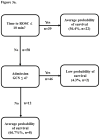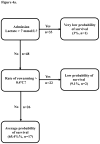EAST Multicenter Trial on targeted temperature management for hanging-induced cardiac arrest
- PMID: 29677083
- PMCID: PMC6026030
- DOI: 10.1097/TA.0000000000001945
EAST Multicenter Trial on targeted temperature management for hanging-induced cardiac arrest
Abstract
Background: We sought to determine the outcome of suicidal hanging and the impact of targeted temperature management (TTM) on hanging-induced cardiac arrest (CA) through an Eastern Association for the Surgery of Trauma (EAST) multicenter retrospective study.
Methods: We analyzed hanging patient data and TTM variables from January 1992 to December 2015. Cerebral performance category score of 1 or 2 was considered good neurologic outcome, while cerebral performance category score of 3 or 4 was considered poor outcome. Classification and Regression Trees recursive partitioning was used to develop multivariate predictive models for survival and neurologic outcome.
Results: A total of 692 hanging patients from 17 centers were analyzed for this study. Their overall survival rate was 77%, and the CA survival rate was 28.6%. The CA patients had significantly higher severity of illness and worse outcome than the non-CA patients. Of the 175 CA patients who survived to hospital admission, 81 patients (46.3%) received post-CA TTM. The unadjusted survival of TTM CA patients (24.7% vs 39.4%, p < 0.05) and good neurologic outcome (19.8% vs 37.2%, p < 0.05) were worse than non-TTM CA patients. However, when subgroup analyses were performed between those with an admission Glasgow Coma Scale score of 3 to 8, the differences between TTM and non-TTM CA survival (23.8% vs 30.0%, p = 0.37) and good neurologic outcome (18.8% vs 28.7%, p = 0.14) were not significant. Targeted temperature management implementation and post-CA management varied between the participating centers. Classification and Regression Trees models identified variables predictive of favorable and poor outcome for hanging and TTM patients with excellent accuracy.
Conclusion: Cardiac arrest hanging patients had worse outcome than non-CA patients. Targeted temperature management CA patients had worse unadjusted survival and neurologic outcome than non-TTM patients. These findings may be explained by their higher severity of illness, variable TTM implementation, and differences in post-CA management. Future prospective studies are necessary to ascertain the effect of TTM on hanging outcome and to validate our Classification and Regression Trees models.
Level of evidence: Therapeutic study, level IV; prognostic study, level III.
Conflict of interest statement
Figures







References
-
- Gunnell D, Bennewith O, Hawton K, Simkin S, Kapur N. The epidemiology and prevention of suicide by hanging: a systematic review. Int J Epidemiol. 2005;34(2):433–42. - PubMed
-
- Martin MJ, Weng J, Demetriades D, Salim A. Patterns of injury and functional outcome after hanging: analysis of the National Trauma Data Bank. Am J Surg. 2005;190(6):836–40. - PubMed
Publication types
MeSH terms
Grants and funding
LinkOut - more resources
Full Text Sources
Other Literature Sources
Medical
Research Materials

